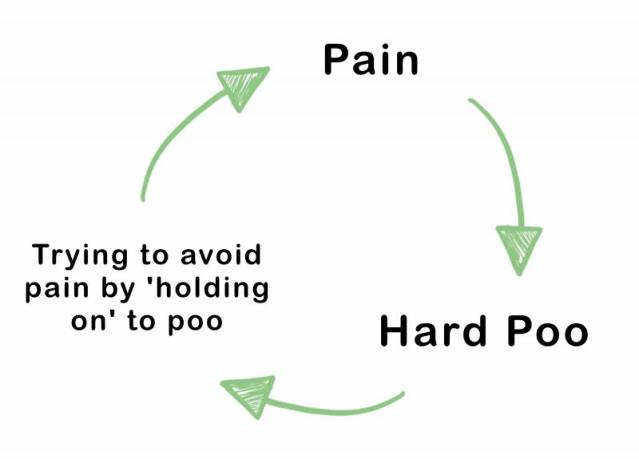Key points about constipation
- constipation is when your child has hard, infrequent poo
- it is a common problem in childhood
- constipation often starts after 1 hard poo has caused pain and so your child has tried to avoid pain the next time by 'holding on' to the poo, resulting in a vicious cycle
- increasing the fluid your child drinks and the amount of fibre in their diet can help prevent constipation
- laxatives are often necessary - they work by making the poo softer and easier to poo out
- sitting on the toilet regularly is important
- tamariki (children) often need laxatives for months and sometimes years to manage the problem
Normal poo
There is a wide range of normal pooing for breastfed pēpi (babies). They may poo as often as after every feed or as infrequently as once in 10 days. The poo of breastfed pēpi is mustard yellow, soft and can look like it has seeds in it.
Most bottlefed pēpi and older tamariki will have a poo every day or every second day. Some have more than one poo a day. The poo should be like a soft log - like type 4 in the diagram below.

You can download and share or print a copy of the KidsHealth poo chart below.

Source: KidsHealth
What is constipation?
If your child of any age has firm, hard or painful poo, they are likely to be constipated. If pēpi or tamariki are not breastfeeding and are pooing less than every 3 days, they are likely to be constipated.

Signs and symptoms of constipation
Your child may be constipated if they have some of the following:
- large and hard poo
- hard 'pebble-like' poo
- no poo for 3 or more days
- pain or crying when having a poo
- bright blood around the poo due to tears in the skin around the anus (anal fissures)
- tummy pain
- urinary tract infections, wetting pants (urine incontinence), bedwetting - constipation can increase the risk of these
- liquid poo that may leak out at times in between harder poo
- soiling accidents (encopresis)
Causes of constipation
Constipation in tamariki is common.
There are many possible reasons for your child's constipation. Often, it is several things:
- not drinking enough water
- weaning from breastmilk to formula
- starting solids
- not having enough fibre (vegetables, fruits, whole grains) - ready-made food and takeaways are low in fibre
- not doing much physical activity
- not eating and drinking as much as normal, for example when your child is unwell
- a natural tendency to having slower gut movement
Toileting habits are important. Your child can become constipated if they:
- ignore the urge to do a poo
- don't let all the poo come out when going to the toilet
- don't sit on the toilet regularly
A video on why constipation happens to children and what you can do to fix it.
Source: Pediatric Gastroenterology Clinic, Primary Children's Hospital, US.
How constipation can cause a vicious cycle
Constipation often starts after 1 hard poo has caused pain. The natural response to a painful experience is to try and avoid or escape it in the future. So, the next time your child feels the urge to poo, they 'hold on' in an attempt to avoid passing another painful poo. This results in the poo becoming firmer, larger and even more painful to poo out and your child becomes even more reluctant to poo in the future.
This leads to a vicious cycle:

The key to stopping this cycle is making the poo soft again. Find out what you can do about your child's constipation.
When constipation continues for a long time
If constipation continues for a long time and all the poo doesn't come out, the bowel can become overloaded and stretched. The overloaded and stretched bowel means the feeling of needing to do a poo is lost and can cause soiling accidents.
Can childhood constipation be due to an abnormal bowel?
Constipation is hardly ever due to an abnormal bowel. Most bowel problems show up in early life and are diagnosed within the first few months. Occasionally, constipation in tamariki can be due to coeliac disease.
If your child passed meconium (the green/black poo newborn babies pass) within 24 hours of birth, it is unlikely your child has a bowel problem causing constipation.
Your health professional may suggest your child see a specialist nurse or doctor if:
- your child's constipation is proving difficult to treat after standard treatments or,
- the health professional thinks there may be another condition causing your child's constipation
Acknowledgements
Illustrations and stool chart adpation by Dr Greta File. Property of KidsHealth.
References
ESPGHAN and NASPGHAN. 2014. Evaluation and treatment of functional constipation in infants and children: Evidence-based recommendations from ESPGHAN and NASPGHAN.
Royal Children's Hospital, Melbourne. Clinical Practice Guideline: Constipation.
National Institute for Health and Clinical Excellence, U.K. May 2010. (Updated 2017). Constipation in children and young people.
